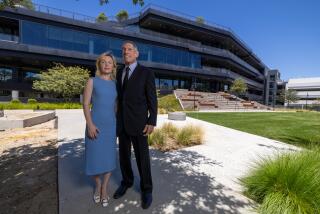Architect’s Works Were Built to Last--So Was He
The West’s first drive-up shopping center, built on the Pasadena-Altadena border in 1930, was unique and somewhat daring in its time. Today, with its integrity still intact, it qualifies as a historical treasure.
The same can be said of its architect, Theodore Pletsch.
Both are enjoying a renaissance this spring. The 56-year-old complex has been renovated for a grand reopening, and the 84-year-old Pletsch is being honored for having designed hundreds of Pasadena-area buildings that stand as testimonials to his talents.
The mini-mall, now known as Hen’s Teeth Square, is on the corner where Los Robles Avenue meets Woodbury Road. It was built when cars were rare and roads leading to it were narrow and unpaved. After more than five decades of abuse by nature and people, it still has its original Italian tiles, thick brick walls and classic beauty.
Standing in front, where gasoline pumps once lured the automobile trade, Pletsch gazed at his creation and said, “This place didn’t make any sense to me at the time. The only people who had cars in 1930 were rich people who had chauffeurs to drive their limousines. Never did think much of it.”
He pointed to a nearby building which he liked more than the shopping center. It was a building he designed in the 1940s as an A & P grocery store and which now houses a plumbing business.
“They gave me jobs for 50 more buildings,” the architect said of the grocery chain.
Pletsch says that kind of thing often, telling of a string of Planned Parenthood clinics, insurance offices, stores along Pasadena’s Colorado Boulevard and homes for the upper crust--built for customers who were so pleased with his work they kept ordering more.
There is a map at Hen’s Teeth Square with pins marking the sites of buildings Pletsch designed, but it is incomplete because he ran out of pins after several hundred were used. Most of the pins are poked in the Pasadena and San Marino areas, where Pletsch designed hundreds of homes in a variety of architectural styles. There are at least 20 pins along San Marino’s elegant Lombardy Road.
Pletsch said he has designed 1,300 buildings; most of them are in the San Gabriel Valley, but some are in other states. Some notable local works still standing are three blocks of Colorado Boulevard storefronts done in the 1920s when the street was widened, a house that won a local design competition in 1935, a 1950s office building on Huntington Drive at Del Mar Avenue, the classic San Marino Tribune building, and a two-story store at 609 E. Green St. in Pasadena with a black tile facade.
“No way I could make sense of a black building,” Pletsch said of the landmark.
“I did those Planned Parenthood buildings and a mausoleum in Brea. See, I’ve designed for people before they’re born and after they’re dead.
“I only design what the customer wants. I’m no Frank Lloyd Wright--never wanted to be. It’s been so much fun I’ve never worked a day in my life. I’ve never been sued, and now one in six architects is sued every year.”
In his youth, Pletsch said, he was an unlikely candidate for success.
“I was a sickly, skinny kid,” who came from the Midwest to California in 1912, he said. “I barely survived the flu epidemic that killed millions of people all over the world in 1918.”
He graduated from the USC School of Architecture in 1925, and was denied life insurance because of his fragile health.
“That was one of the best things that ever happened to me,” Pletsch said. He learned to struggle against odds, to build up his strength by mountain climbing, and to work as hard as he could.
Pletsch still lives in the Altadena home he designed in 1936 for his late wife and two children. He is a sprightly, slender man who claims to have logged at least 30,000 miles hiking in the San Gabriel Mountains. Almost weekly he takes his favorite trail from Eaton Canyon to Henninger Flats, a 10-mile round trip that can exhaust people a fraction of his age.
Although he never formally retired, Pletsch works only occasionally now. He might have gone unrecognized for his enormous output had it not been for the owners of Hen’s Teeth Square, who tracked him down after finding old documents in the building’s basement.
Jeanette Henderson, who with her husband, Winston, bought the building in 1978, said they named it Hen’s Teeth because money for development was scarce then. Also, she said, “We want this to be for things that are as rare as hen’s teeth--things you can’t get anywhere else in this area.”
The building, designated a historic landmark in 1982, is scheduled to reopen in mid-May with a sidewalk cafe, specialty food shops, a produce market and space for a museum of local history.
Pletsch said he is not involved with the restoration but is pleased with what he sees. He pointed out that even though it was built long before reinforcement was required for masonry structures, he used special reinforcing beams in the building and to this day it has only one crack, which he attributes to an underground weakness, perhaps an old cesspool nobody knew about.
Asked why teh building survived countless earthquakes, Pletsch had a ready answer.
“Because I designed it.”
More to Read
Sign up for Essential California
The most important California stories and recommendations in your inbox every morning.
You may occasionally receive promotional content from the Los Angeles Times.










